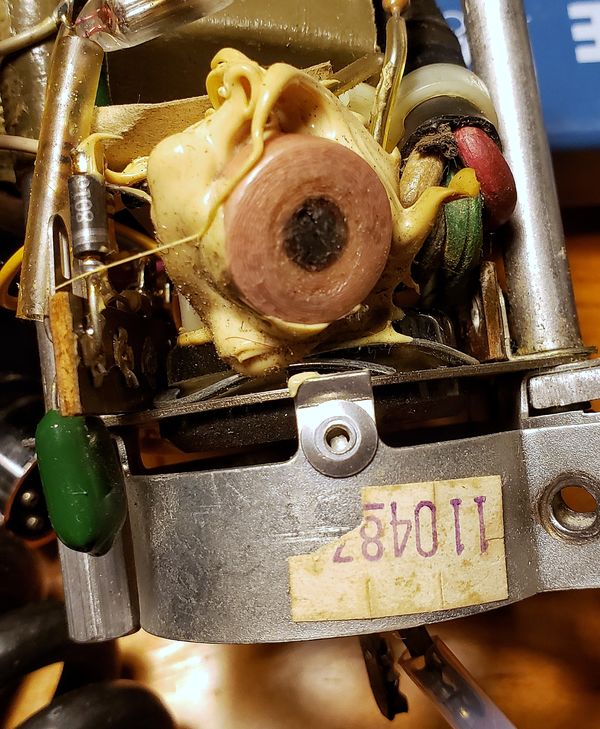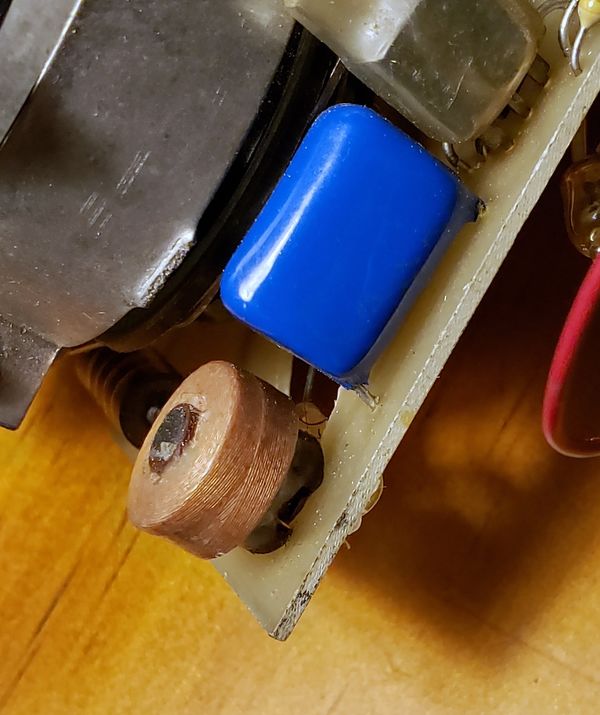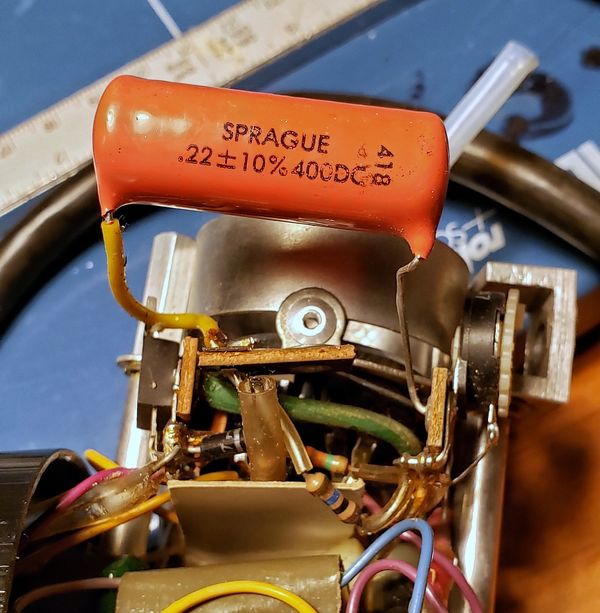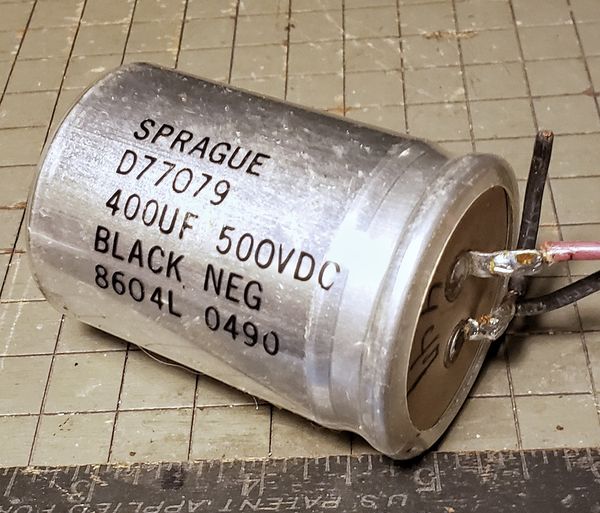Strobe capacitors "deforming?"
Jun 23, 2019 21:08:12 #
flashbang wrote:
I seem to remember being advised that electronic flash units had to had to be "fired up" regularly if they were not being used to prevent the capacitors from "deforming." I have no idea of what that means ir of it is necessary, but I do try to make sure that units that have not been used for a few months are fitted with fresh batteries and turned on for an hour or so.
Is this necessary or just some antiquated superstition?
Is this necessary or just some antiquated superstition?
You have to fire the flash a few times to reform or refresh the capacitor.
In almost all flash units, the storage capacitor (which stores the electrical energy that energizes the flash tube) is of the electrolytic type. In that type of capacitor, the dielectric (the insulating layer between the two electrodes of the capacitor) is a thin film of aluminum oxide on one of the aluminum electrodes, created by an electrochemical process.
If the capacitor isn't charged for a long time, that dielectric layer can "deform" (degrade), causing the capacitor to electrically "leak", with the result that (depending on the nature of the charging circuit) it will not fully charge and/or may heat up internally.
Jun 23, 2019 21:33:50 #
My experience is that the capacitors in many kinds of electronic flash units; strobes, studio units, speedlights, monolights, and one and two-piece older portables can become be deformed if left dormant and unused for long periods of time. It is best, therefore, if you want to keep them serviceable you have to do a simple procedure periodically.
Turn the unit on but DO NOT fire it for about an hour. Then fire it several times. When firing it, observe it and make certain the ready light is coming on regularly and does no extinguish intermittently between flashes. Do this procedure at full power on units that have fixed power settings. On thyristor controlled auto-flash models, cover the receptor in order to obtain full power. If all goes well, repeat the procedure at the various fixed power settings or hold the flash at various distance from a wall to activate the thyristor system and achieve various outputs. The recycling times should be uniform at each given power output. The higher the output, the longer the recycling time.
When doing this procedure at various fixed power settings, make sure the unit is fully recycled before changing power settings. On some older units, NOT doing that can burn out the power selector switch or dial.
Symptoms of capacitors that are deformed and are malfunctioning are: 1) the unit will not fire up at all-DEAD! 2) It will turn on but won't produce enough power to activate the ready light, 3) There could be a crackling or popping sound accompanied by smoke or the odor of burning plastic or phenolic material emanating from the unit. 4)The ready light may extinguish or flicker irregularly- not the normal regular blinking that some readr lights will do. 5) There could be a loud BANG when a deformed capacitor causes a short circuit across another capacitor in the circuit. 6) The flash tube will glow at a very high output and remain on rather than flashing- this indicating that the capacitors are completely inoperative and there is a flow, rather than a pulse, of high voltage directly to the lamp head or flash tube.
If any of the above symptoms occur, shut the unit off immediately. There are also other components that can dry up or burn out such as trigger coils or smaller capacitors in the trigger circuit.
The viability and economics of repair will depend on the original value of the unit and the condition of other parts such as high voltage connector cables, flash tubes, and lamp heads and the current availability of replacement parts.
I have not seen oil-filled capacitors in any unit manufactured after the mid-1950s. These units operated at extremely high voltages and capacitor with a comparatively low rating in microfarads.
At my studio, I have units that are still operating perfectly after 30 or more years of service. I use them regularly and fire the spares up as I explained above. Regular maintenance includes general cleaning, replacement of carbonized or blackened flash tubes and careful cleaning of all contacts, sockets and battery compartments.
I am not claiming to understand the chemistry or inner workings of electrolytic capacitors and if "forming" or "reforming" is not the proper nomenclature or correct technical word from an engineering point of view, I apologize. These procedures and descriptions of symptomatic indicators of malfunctioning capacitors are strictly based on experience. When a unit came into our shop with theses specific symptoms, the capacitors were usually at fault. We did have instrumentation, capacitors testers, to check suspect capacitors. On custom builds we could check out new capacitors and determine their exact values. In some cases on the older unit we were able to reform certain capacitors, others required replacement. The procedure I firstly outlined in more of a preventative measure.
Remember, older units should NEVER be directly connected to a digital camera unless the trigger voltage is checked and found to be well within the safe parameters determined by the camera manufacturers. Safe-Sync or Paramount protection devices should be used or the flash should be synchronized by radio. Even if the trigger voltage is considered safe, a flash unit suspected of any malfunction should never be connected to any camera. Short circuits or defective or burned out components can direct extremely high voltages and current into the camera- and the PHOTOGRAPHER !
A don't like to be an "alarmist" but when folks mention old dormant units, I always prefer to issue this warning. I've seen some pretty nasty damage caused by old strobes. I don't wanna see any of my photographer friends become a crispy-critter. Cameras are replaceable- burned out nerve endings, and other injuries caused by electrocution are harder to fix. Y'all remember the electric chair!?


Turn the unit on but DO NOT fire it for about an hour. Then fire it several times. When firing it, observe it and make certain the ready light is coming on regularly and does no extinguish intermittently between flashes. Do this procedure at full power on units that have fixed power settings. On thyristor controlled auto-flash models, cover the receptor in order to obtain full power. If all goes well, repeat the procedure at the various fixed power settings or hold the flash at various distance from a wall to activate the thyristor system and achieve various outputs. The recycling times should be uniform at each given power output. The higher the output, the longer the recycling time.
When doing this procedure at various fixed power settings, make sure the unit is fully recycled before changing power settings. On some older units, NOT doing that can burn out the power selector switch or dial.
Symptoms of capacitors that are deformed and are malfunctioning are: 1) the unit will not fire up at all-DEAD! 2) It will turn on but won't produce enough power to activate the ready light, 3) There could be a crackling or popping sound accompanied by smoke or the odor of burning plastic or phenolic material emanating from the unit. 4)The ready light may extinguish or flicker irregularly- not the normal regular blinking that some readr lights will do. 5) There could be a loud BANG when a deformed capacitor causes a short circuit across another capacitor in the circuit. 6) The flash tube will glow at a very high output and remain on rather than flashing- this indicating that the capacitors are completely inoperative and there is a flow, rather than a pulse, of high voltage directly to the lamp head or flash tube.
If any of the above symptoms occur, shut the unit off immediately. There are also other components that can dry up or burn out such as trigger coils or smaller capacitors in the trigger circuit.
The viability and economics of repair will depend on the original value of the unit and the condition of other parts such as high voltage connector cables, flash tubes, and lamp heads and the current availability of replacement parts.
I have not seen oil-filled capacitors in any unit manufactured after the mid-1950s. These units operated at extremely high voltages and capacitor with a comparatively low rating in microfarads.
At my studio, I have units that are still operating perfectly after 30 or more years of service. I use them regularly and fire the spares up as I explained above. Regular maintenance includes general cleaning, replacement of carbonized or blackened flash tubes and careful cleaning of all contacts, sockets and battery compartments.
I am not claiming to understand the chemistry or inner workings of electrolytic capacitors and if "forming" or "reforming" is not the proper nomenclature or correct technical word from an engineering point of view, I apologize. These procedures and descriptions of symptomatic indicators of malfunctioning capacitors are strictly based on experience. When a unit came into our shop with theses specific symptoms, the capacitors were usually at fault. We did have instrumentation, capacitors testers, to check suspect capacitors. On custom builds we could check out new capacitors and determine their exact values. In some cases on the older unit we were able to reform certain capacitors, others required replacement. The procedure I firstly outlined in more of a preventative measure.
Remember, older units should NEVER be directly connected to a digital camera unless the trigger voltage is checked and found to be well within the safe parameters determined by the camera manufacturers. Safe-Sync or Paramount protection devices should be used or the flash should be synchronized by radio. Even if the trigger voltage is considered safe, a flash unit suspected of any malfunction should never be connected to any camera. Short circuits or defective or burned out components can direct extremely high voltages and current into the camera- and the PHOTOGRAPHER !
A don't like to be an "alarmist" but when folks mention old dormant units, I always prefer to issue this warning. I've seen some pretty nasty damage caused by old strobes. I don't wanna see any of my photographer friends become a crispy-critter. Cameras are replaceable- burned out nerve endings, and other injuries caused by electrocution are harder to fix. Y'all remember the electric chair!?


Jun 23, 2019 21:40:26 #
E.L.. Shapiro wrote:
My experience is that the capacitors in many kinds... (show quote)
Coils don't normally dry out, they are just sets of wire wound around a metal core, held in place by a "glue".
Jun 23, 2019 21:47:14 #
RWR
Loc: La Mesa, CA
BebuLamar wrote:
both your and mine say about the same thing. You don't need to fire the flash 10 times like someone said. You need to charge the capacitor up and keep it charged for some time.
Right. And CO shows that Nikon says to fire the SB-700 several times once a month - points out the importance of reading the manual!
Jun 23, 2019 22:13:40 #
Harry0
Loc: Gardena, Cal
There's also "cap rot". A couple different forms.
Too many heat cycles will also burn/dry them out. You may not even notice- it doesn't hold as much charge, so it has to discharge more before there's an adequate amount of light. Or that wedding photog, using his 4x 1.2volt D-cell power pack to keep his 3AA flash going for a few hundred shots- "wears" out that flash head.
Now, a bit of history:
Once upon a time there was this electronics facility.
It was a good one. But hackers and spies kept trying to access it's databases.
What to do ...
They used MAC address confirmations and oubliettes.
If you were outside, using my name and password, not my PC, you might go to PlanB.
If you were outside, and got the name and password wrong 10x, you'd go to PlanB.
PlanB was a separate server, full of failed projects, bad designs, maybe a virus or two.
This company designed a new capacitor: slightly different chemistry, more effective, cheaper to make.
The version the hackers stole was a flawed design, with a limited half life of heat cycles..
Suddenly, it seemed that all of Asia and half of North America was making/using this flawed version.
For years, IT had to worry about this. PC problems- check for bulgy caps on the mobo. PC has to be turned on twice to work- caps. Phone call- "My computer is bleeding!" - power supply caps.
Remember maybe 20 to 30 years back there was a big worry about "sabotage" in our armed forces electronics? Bad caps. Various mid and upper range stereo and TVs had intermittent issues. I bought a couple "rebuild" kits for Marantz receivers- mostly caps, with some LED replacement lamps.
You'd never know when they'd fail. They looked and tested just like the "real" ones.
Too many heat cycles will also burn/dry them out. You may not even notice- it doesn't hold as much charge, so it has to discharge more before there's an adequate amount of light. Or that wedding photog, using his 4x 1.2volt D-cell power pack to keep his 3AA flash going for a few hundred shots- "wears" out that flash head.
Now, a bit of history:
Once upon a time there was this electronics facility.
It was a good one. But hackers and spies kept trying to access it's databases.
What to do ...
They used MAC address confirmations and oubliettes.
If you were outside, using my name and password, not my PC, you might go to PlanB.
If you were outside, and got the name and password wrong 10x, you'd go to PlanB.
PlanB was a separate server, full of failed projects, bad designs, maybe a virus or two.
This company designed a new capacitor: slightly different chemistry, more effective, cheaper to make.
The version the hackers stole was a flawed design, with a limited half life of heat cycles..
Suddenly, it seemed that all of Asia and half of North America was making/using this flawed version.
For years, IT had to worry about this. PC problems- check for bulgy caps on the mobo. PC has to be turned on twice to work- caps. Phone call- "My computer is bleeding!" - power supply caps.
Remember maybe 20 to 30 years back there was a big worry about "sabotage" in our armed forces electronics? Bad caps. Various mid and upper range stereo and TVs had intermittent issues. I bought a couple "rebuild" kits for Marantz receivers- mostly caps, with some LED replacement lamps.
You'd never know when they'd fail. They looked and tested just like the "real" ones.
Jun 23, 2019 22:27:42 #
Harry0
Loc: Gardena, Cal
"Older" flash units sometimes had hundreds of volts running thru that shoe mount or flash cable. The camera was just a mechanical relay switch. the flash just fired. If you thought you needed more light, screw in a bigger lamp.
Newer ones (flashes and cameras) are bit more delicate- lower voltages, lower amperages.
Quite a few camera OEMs would warn you about this- use flash bulb flash ...
Well you wanted a new camera anyway. Some places sold "isolators" to prevent this. Been a while, tho.
Newer ones (flashes and cameras) are bit more delicate- lower voltages, lower amperages.
Quite a few camera OEMs would warn you about this- use flash bulb flash ...
Well you wanted a new camera anyway. Some places sold "isolators" to prevent this. Been a while, tho.
Jun 23, 2019 22:54:32 #
CO wrote:
This is from the owner's manual of my Nikon SB-700 flash. The last bullet describes how to refresh the capacitor.
Thanks for the reminder. It's been a while.

--
Jun 23, 2019 23:20:06 #
RWR
Loc: La Mesa, CA
Longshadow wrote:
You don't have to "form the flash capacitor". 





You are wrong. Read what BebuLamar quoted. Also here:
https://www.manualslib.com/manual/102764/Metz-Mecablitz-44-Mz-2.html?page=20#manual
Jun 23, 2019 23:32:49 #
RWR wrote:
You are wrong. Read what BebuLamar quoted. Also here:
https://www.manualslib.com/manual/102764/Metz-Mecablitz-44-Mz-2.html?page=20#manual
https://www.manualslib.com/manual/102764/Metz-Mecablitz-44-Mz-2.html?page=20#manual
Don't believe me, I'm just an electronics engineer with only 50 years of experience.

(You do know that they could be referencing a precautionary operation (CYA) of a unit that could have been sitting in a warehouse or store for a very long time, correct?)
Jun 23, 2019 23:46:30 #
Longshadow wrote:
Don't believe me, I'm just an electronics engineer with only 50 years of experience. 
(You do know that they could be referencing a precautionary operation (CYA) of a unit that could have been sitting in a warehouse or store for a very long time, correct?)

(You do know that they could be referencing a precautionary operation (CYA) of a unit that could have been sitting in a warehouse or store for a very long time, correct?)
Better to err on the side of caution?
---
Jun 23, 2019 23:46:55 #
Longshadow wrote:
Coils don't normally dry out, they are just sets of wire wound around a metal core, held in place by a "glue".
Well-I wishes I had a $5 bill for every one of the trigger coils I replaced for clients. I wouldn't be a millionaire but I could take one heck of a vacation! The two coils in the attached picture are trigger coils circa 1987- earlier ones were magnet wire, paper and a core set in wax or some kinda epoxy. Sometimes the wax, glue or whatever the stuff was would dry up and breakdown or the coil would overheat a burn. Also, shown is a typical trigger capacitor found in lamp heads or in the housing of a speedlight near the flash tube- they sometimes burn out too. Oftentime the heat for modeling lamps can affect the circuitry in the lamp head or monolight.
I no longer service units for other folk and only maintain and repair my own. The innards in the picture are two old units I am repairing- issues in the trigger circuits.
I did not intend my post as an electronics lesson-- I just wanted to answer the OP's question and verify that this capacitor reforming thing is not an urban legend or a myth and supply a bit of background information and suggest a maintenance procedure that has served me well.
Also included here is a picture of a dead capacitor for the power supply of a Lumadyne flash unit. Notice, it is not burned, swollen or outward damaged- it deformed and never recovered. It was part of a Lumadyne booster pack that I had forgotten about and it was accidently neglected .




Jun 24, 2019 01:21:27 #
RWR
Loc: La Mesa, CA
Longshadow wrote:
Don't believe me, I'm just an electronics engineer with only 50 years of experience. 
(You do know that they could be referencing a precautionary operation (CYA) of a unit that could have been sitting in a warehouse or store for a very long time, correct?)

(You do know that they could be referencing a precautionary operation (CYA) of a unit that could have been sitting in a warehouse or store for a very long time, correct?)
All I know is what the manuals say. Neither of my Metz units have sat idle for more than a month or so since I bought them new, and so far they’ve been trouble free. I assume that’s at least partly due to the fact that the capacitors have never been left in a discharged state. “Formed” may be Metz-specific for all I know.
Jun 24, 2019 05:38:08 #
billnikon
Loc: Pennsylvania/Ohio/Florida/Maui/Oregon/Vermont
flashbang wrote:
I seem to remember being advised that electronic flash units had to had to be "fired up" regularly if they were not being used to prevent the capacitors from "deforming." I have no idea of what that means ir of it is necessary, but I do try to make sure that units that have not been used for a few months are fitted with fresh batteries and turned on for an hour or so.
Is this necessary or just some antiquated superstition?
Is this necessary or just some antiquated superstition?
I FORM my flash capacitors at least once every 3 months if not more often. This practice is a left over from my professional days but still valid. Just a precaution, but old habits die hard. Insert batteries, flash off about 10 flashes, always wait until your ready light comes on each time. After your last flash leave the unit charged and turn off. Remove batteries. Repeat this as often as u fell necessary.
Jun 24, 2019 06:37:06 #
E.L.. Shapiro wrote:
My experience is that the capacitors in many kinds... (show quote)
Once again you brought quite a bit more to the discussion than, 'trust me, I know', and topped it all off with pictures!
Thank you.



--
Jun 24, 2019 07:06:25 #
johnst1001a
Loc: West Chester, Ohio
never heard of this, anyway i guess ill follow the recommendatio to use the flash occasionally. by the way, i had some batteries start to leak. I was able to clean the contacts. Now I remove the batteries altogether if I don't plan using it for a while. I use name brand batteries, not the real cheap ones.
If you want to reply, then register here. Registration is free and your account is created instantly, so you can post right away.



